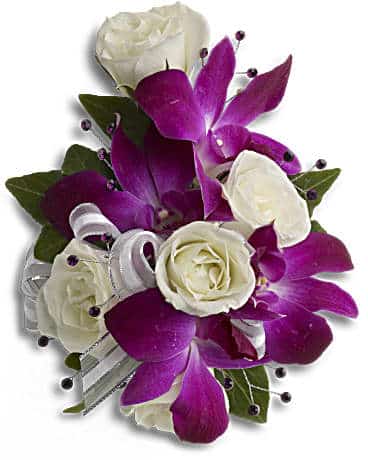Ah, love. We usually think that the month of romance and passion is February. Valentine’s Day lies smack-dab in the middle of the month, and that tends to be the time that lovers express their unbridled feelings to their significant others.
The marriage ceremony, and matrimony itself, has a lot of flowers associated with it, but perhaps the most fun are the wearable floral arrangements: your corsages and boutonniers.
The corsage is of course a traditional favorite, if not a ceremonial necessity. It’s notoriety stems from a ritual in which the new bride tosses the corsage into a crowd of single women. Whoever captures this beautiful bouquet is said be to the next woman amongst them to marry. So naturally, it can become a vicious competition.

Corsages can be worn on the wrist or on a woman’s dress. During weddings, the bride and the bride’s mother and grandmother tend to adorn their own corsages.
Of course, men deserve pretty flowers too. Boutonnieres, or buttonholes, are a single flower pinned to the man’s lapel. Usually a carnation, the color of the flower signifies the formality of the occasion, with white being the most formal. However, a white gardenia may be used instead due to it’s attractiveness and pleasant scent.
Boutonnieres are worn by the groom and his groomsmen, with the groom’s boutonnieres symbolizing his tie to his new bride, and the groomsmens’ boutonnieres signaling their support for the union.
Wearing pinned flowers dates back to Ancient Greece, where it was worn at weddings to ward off evil spirits. The words corsage and boutonniere are French words, with corsage meaning girdle, in reference to where corsages were worn, and boutonniere was specific to the pinned flower on the lapel.
Both corsages and boutonnieres have a diverse number of events that they can be worn at besides weddings, most commonly for school dances such as homecoming and prom. Even more common events, such as church or a nice dinner could warrant a corsage. I know grandmothers love it when their grandsons get them a corsage for family church services.
During formal dances, the gentleman supplies and puts on the corsage for his date. This is to symbolize the gentleman’s consideration and generosity, and the flowers themselves are meant to represent and honor its recipient.
Corsages are diverse, with several flowers able to be used to construct it. Some common flowers used include orchids, roses, lisianthus, carnations, and daisies for the main flower. Some corsages can also be decorated with glitter, gems, ribbons, beads, and artificial leaves. Younger generations tend to use wrist corsages, especially during school dances.
HOW TO PUT ON YOUR DATE’S CORSAGE
- For a pin corsage, unlatch the pin on the back that will be used to attach the dress.
- Position the corsage between your date’s chin and left shoulder, pulling the fabric away from the skin so as not to accidentally harm your date.
- Guide the safety pin through the wrapped wire stem of the corsage, through your date’s dress and back up the wrapped wire stem. Latch the safety pin.
- If a wrist corsage, ask which wrist she would like the corsage placed on. Traditionally it is placed on the left wrist. Have your date hold her hand out with her palm up, and place the corsage on, flower side up.

